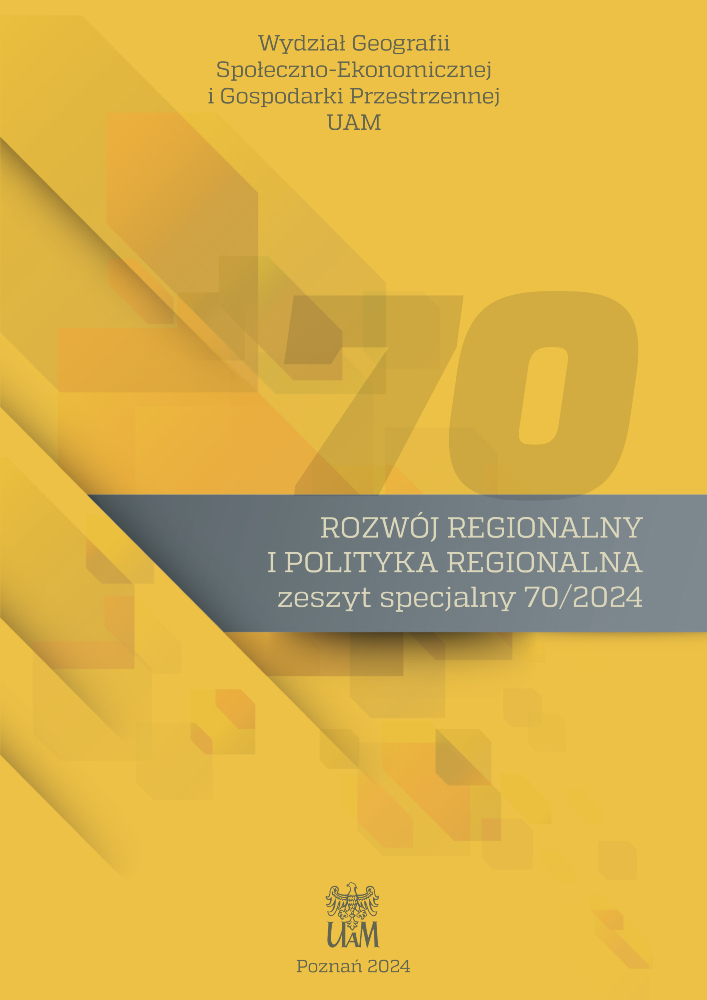Abstract
One of the key challenges of the 21st century is the increasing level of urbanisation, which, combined with the growth of the urban population, creates difficulties in urban management, especially in the field of transport use and organisation. The answer to this is the concept of sustainable mobility, which aims to optimise the management and planning of the development of a city’s transport system while moving away from a sectoral approach, i.e. considering issues on only one level (in this case, the economic aspects). Instead, a holistic approach is proposed, focusing on multifaceted measures that include environmental and social issues in addition to economic ones. One example of the application of such an approach is Kommuneplan 2019, defining Copenhagen’s development plans for the period 2019–2031. The subject of this article is an analysis of Kommuneplan 2019, a document outlining Copenhagen’s development plans, focusing on transport issues in relation to the concept of sustainable mobility. The aim of the article is to present the guidelines of Kommuneplan 2019 on the issues of shaping the urban transport system in Copenhagen and to assess them in terms of the implementation of the sustainable mobility concept. The following research methods were used: desk research, critical document review, expert method and inference. The time horizon of the research is for the years 2019–2023.The work is divided into two parts. In the first, a literature review and an analysis of available documents regulating spatial planning in Copenhagen is carried out. In the second, the individual actions planned by the authors of Kommuneplan 2019 are presented and considered with a breakdown of their economic, environmental and social aspects. The conclusions of the paper focus on the use of a holistic approach taking into account non-economic issues (e.g. environmental and social) and focusing on the diversification of transport modes as necessary when aiming to put the concept of sustainable mobility into practice.
References
Bannister D. 2005. Unsustainable Transport. City Transport in the New Century. Routledge, London. DOI: https://doi.org/10.4324/9780203003886
Bredal F. 2014. The Case of Copenhagen. Changing urban traffic and the role of bicycles: Russian and International Experiences, s. 24−28.
Castelnovo W., Misuraca G., Savoldelli A. 2016. Smart Cities Governance: The Need for a Holistic Approach to Assessing Urban Participatory Policy Making. Social Science Computer Review, 34: 1-16. DOI: https://doi.org/10.1177/0894439315611103
Hebel K., Wyszomirski O. 2014. Plan zrównoważonej mobilności miejskiej jako kompleksowe podejście do planowania mobilności w miastach. TTS Technika Transportu Szynowego, 11-12: 47-52.
Huk K. 2015. Logistyka miejska a społeczna odpowiedzialność biznesu - wspólne obszary zainteresowania. Studia Ekonomiczne, 249: 155-163.
Kiba-Janiak M. 2016. Kluczowe czynniki sukcesu logistyki miejskiej z perspektywy zarządzania miastem. Prace Naukowe Uniwersytetu Ekonomicznego we Wrocławiu, 420: 141-152.
Kiba-Janiak M., Witkowski J. 2014. Modelowanie logistyki miejskiej. Polskie Wydawnictwo Ekonomiczne, Warszawa.
Kommuneplan 2019. 2019. City of Copenhagen (https://kp19.kk.dk/copenhagen-municipal-plan-2019).
Krysiuk C., Brdulak J., Banak M. 2015. Mobilność i komunikacja w miastach polskich. TTT Technika Transportu Szynowego, 12: 881-886.
Kwiatkowski M.A. 2018. Bike-sharing-boom - rozwój nowych form zrównoważonego transportu w Polsce na przykładzie roweru publicznego. Prace Komisji Geografii Komunikacji PTG, 21(3): 60-69. DOI: https://doi.org/10.4467/2543859XPKG.18.017.10142
Makarova I., Pashkevich A., Shubenkova K., Mukhametdinov E. 2017. Ways to Increase Population Mobility through the Transition to Sustainable Transport. Procedia Engineering 187: 756-762. DOI: https://doi.org/10.1016/j.proeng.2017.04.434
Mobilitetsredegørelse 2023. City of Copenhagen (https://www.kk.dk/sites/default/files/2023-06/Mobilitetsredeg%C3%B8relsen%202023.pdf).
Nicolaisen M.S., Olesen K., Olesen M. 2017. Vision vs. Evaluation - Case Studies of Light Rail Planning in Denmark. European Journal of Spatial Development, 15(65): 1-26.
Rześny-Cieplińska J. 2018. Strategie logistyki miejskiej wobec koncepcji smart city na przykładzie miast polskich i zachodnioeuropejskich. Prace Naukowe Uniwersytetu Ekonomicznego we Wrocławiu, 505: 471-480. DOI: https://doi.org/10.15611/pn.2018.505.36
Saniuk S., Witkowski K. 2011. Zadania infrastruktury transportu miejskiego w logistyce miejskiej. Logistyka, 2: 495-506.
Sobol A. 2017. Inteligentne miasta versus zrównoważone miasta. Zeszyty Naukowe Uniwersytetu Ekonomicznego w Katowicach, 320: 75-86.
Taniguchi E. 2014. Concepts of city logistics for sustainable and liveable cities. Procedia - Social and Behavioral Sciences, 151: 310-317. DOI: https://doi.org/10.1016/j.sbspro.2014.10.029
Tundys B. 2012. Wpływ rozwiązań z zakresu logistyki miejskiej na kształtowanie rozwoju regionów. Zeszyty Naukowe Politechniki Śląskiej, 75: 93-102.
Wołek M. 2015. Planowanie zrównoważonej mobilności miejskiej w Polsce i w Europie. TTS Technika Transportu Szynowego, 10: 20-24.
Internet 1 https://kp19.kk.dk/om-kommuneplan-2019 (dostęp: 11.02.2024).
Internet 2 https://www.dinletbane.dk/en/the-vision/stations-and-trains/ (dostęp: 13.02.2024).
Internet 3 https://www.dinletbane.dk/en/the-vision/ (dostęp: 9.02.2024).
License
Copyright (c) 2024 Jakub Sokołowski

This work is licensed under a Creative Commons Attribution 4.0 International License.

